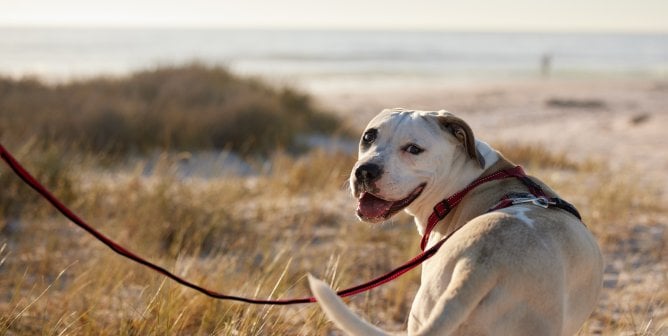Take this quiz to find out if you’re a communicator or a dictator.
You and your dog speak different languages. Dogs have millions of years of evolutionary baggage telling them that digging in the flower bed is the proper way to store food and that barking is a vital form of communication. Your job is to explain that here in the land of naked apes, certain behaviors don’t always go over well, while others, like darting out into the road, are downright dangerous. The question is, are you educating your dog like a kindergarten teacher or a drill sergeant? Take this quiz to find out.
1) The Western you’re watching on TV has just gotten to the big shootout scene when Rover starts whining at the door. You:
a. promise yourself that SOMEDAY you’ll see this movie all the way through as you hop up and let Rover out.
b. ignore Rover until the next commercial, then let him out. Getting up now just rewards him for whining, which you are trying to teach him to stop doing anyway.
c. tell Rover “No.” He needs to learn he can’t go in and out every five minutes.
Answer: a. HELLO! Rover is VERY politely telling you he needs to go outside. (So what if he just went out five minutes ago, he obviously forgot to do something important!) Ignoring Rover’s whine is like ignoring someone’s “please” and forces him to move on to something “rude” like scratching the door or having an “accident.” If you ABSOLUTELY can’t let Rover out right away, at least acknowledge him: “I hear you, buddy—I’m coming.” Telling him “no” is the cruelest of all—imagine telling someone that you have to go the bathroom and they say “no!” Tell it to your bladder!
2) Maggie is a confirmed “chow hound.” Every night at dinner, she hovers at your chair, drools on your knee, and tries to “steal” food off the table. What should you do?
a. Slip her some tidbits every few minutes—she’s so pathetic!
b. Never give her scraps; this only encourages her and makes her want “people” food instead of dog chow.
c. Tell her to lie down and stay until dinner is over, then reward her with scraps.
d. None of the above.
Answer: c. Go ahead and give poor Maggie some variety in her life and feed her nutritious table scraps, just make sure you feed scraps at the RIGHT time. First, always feed Maggie her dinner BEFORE yours. If she still comes begging, ask her to lie down and stay. Teaching Maggie to wait for her tidbits calmly is really kinder than keeping her anxious by sporadically slipping her food. (Often, dogs doze off on a down/stay, which is as relaxing as it gets!) Slipping Maggie morsels during dinner TEACHES her to beg, unfairly setting her up for a scold when you decide that paw-swipes at your arm are no longer cute, or when you’re entertaining dinner guests.
3) Fido knocks the wind out of everybody he meets with an enthusiastic pair of paws planted firmly on the chest. How can you stop him from jumping?
a. Step on Fido’s back feet so he learns to associate discomfort with jumping up.
b. Give visitors food treats and instruct them to tell Fido to sit when he greets them.
c. Put your knee up as Fido jumps, so he hits the knee instead of you.
d. None of the above.
Answer: b. Stepping on Fido’s back feet is unnecessary and painful and could cause injury. Same goes for kneeing. Fido is jumping on people because he is happy to see them; do you really want him to associate being friendly with pain? Why hurt and confuse Fido when asking him to express his greeting in a different way, such as sitting, gets the message across?
4) Princess is busy chewing on a tasty sofa cushion. You walk into the room and wail, “Princess!” She looks up, drops the cushion, and bounds over to you, joyfully wagging her tail. You:
a. tell her she’s a bad dog and give her a stern lecture on the high cost of sofa cushions.
b. turn around and ignore her.
c. bite your tongue and give her a pat and a hug.
Answer: c. This is perhaps the most important rule you can learn about communicating with your dog: NEVER, EVER, EVER SCOLD A DOG WHO COMES TO YOU WILLINGLY—no matter how long she dawdled, no matter how bad she was mere seconds before. If Princess had ignored you and kept right on chewing, then saying, “No! Chew on THIS,” as you took away the pillow and handed her a toy would have been in order; but she didn’t—she stopped her “bad” behavior and came to you instead. Coming to you should ALWAYS be a thrilling experience; scold her and she learns—not to stop chewing cushions—but that coming to you isn’t always such a great idea.
5) Benji is the Joan Rivers of dogdom. He barks at EVERYTHING: the moon, the sun, dogs, cats, squirrels, cockroaches, dust mites. How can you get him to quit that incessant yapping?
a. Give Benji a biscuit to distract him.
b. Sneak up behind Benji and startle him with a swat him on the rump as you yell, “No!”
c. Get one of those nifty electronic collars that zaps Benji whenever he utters a peep.
d. None of the above.
Answer: d. For starters, how come people can talk all day, but one peep out of Benji gets a “shut up” from you? Benji is barking because he’s trying to tell you something—”Look out, here comes that guy in the noisy truck!” or, “Hey, I’m lonely out here by myself,” or, “I’m terribly bored; can we go for a walk now?”
But what if you’re not feeling particularly interested in what Benji has to say about the trash truck at 7 a.m.? Hitting Benji and shouting at him is cruel and unfair—you’re punishing him for something he thinks is very important—alerting you to intruders (an instinct you’ll thank him for if a burglar shows up!)
Electronic shock collars are no better: They punish Benji indiscriminately (and painfully), plus they have a number of other drawbacks. Dogs trained with shock collars and “electronic fences” may develop fears or aggression aimed at what they BELIEVE is the source of that pesky shock—kids riding by on bikes—whom Benji starts to chase and bark at until he gets an unpleasant surprise—or the dog next door, who “administers” a painful jolt every time Benji runs up to play (two confused and frustrated dogs once killed a neighboring dog when he crossed the boundary to play). Dogs have also been known to run heedlessly through electronic barriers in hot pursuit of a squirrel or fleeing scary fireworks, then become terrified to cross back through it.
So what can you do? Ask Benji to do something else! Start making 7 a.m. on trash day practice-lying-down time until Benji gets the idea that lying down is the thing to do when the garbage truck comes. (Give Benji a treat only AFTER he does what you ask, not before, otherwise you will be TRAINING him to bark!) You also may try teaching Benji the meaning of the word “quiet” by GENTLY closing his mouth with your hands (no rough treatment, you’re simply showing him what “quiet” means) as you say the word. Remember, don’t lose your temper, holler, or otherwise abuse or over-use the “quiet” command—let Benji talk sometimes!
6) While you were at work, Fluffy emptied the trash can and created a lovely “mixed media artwork” of soda cans, melon rinds, and shredded plastic wrap on the living room floor. What should you do when you come home?
a. Bring Fluffy over to her “masterpiece,” rub her nose in it, and tell her “bad dog!”
b. Lock Fluffy in the garage every day until she learns her lesson.
c. Act like Fluffy’s redecorating is no big deal and figure out where to put the trash can so she can’t get into it.
Answer: c. Naughty human! What Fluffy did was YOUR FAULT for failing to supervise her! (OK, so you can’t quit your job and watch her all day but that’s not HER fault!) Corrections work only as a warning IMMEDIATELY beforehand (“Na-aah-aah, don’t even think of touching that trash can!”) or while Fluffy is “in the act.” If you wait until hours (or even minutes) later, Fluffy will think she’s being scolded for what she’s doing RIGHT NOW, such as being happy to see you!
The solution lies, as always, in prevention. Your best bet is to stash the trash in a pantry or “kid-safe” cabinet. (Confining Fluffy works for YOU, but it doesn’t solve HER basic problems-boredom, loneliness, and lots of energy.) Make sure Fluff has a variety of toys (and/or companions) to keep her occupied and that she gets plenty of exercise, particularly in the morning: A tired dog wants to sleep, not redecorate!
How’d You Score?
Give yourself a point for each correct answer.
0-2: Hey, Mussolini, lighten up! How about we yell at you for getting sick on the carpet, smack you for talking to your friends, lock you in the basement for raiding the refrigerator, and see how YOU like it!
3-4: You’re not quite fluent in “dog-ese” yet, but you’re getting there. Brush up on your communicating skills by reading a book like Dogs Behaving Badly by Dr. Nicholas Dodman or Don’t Shoot the Dog by Karen Pryor, and sign yourself up for a good training class.
5-6: Gandhi would be proud! Now go spend some quality time with that lucky pooch of yours!
Win bonus points if you do the following:
- Stop and smell the roses—and the fire hydrants! Imagine the frustration of sitting around the house all day waiting for a walk and then, when you get one, being hauled around the block without ever getting a chance to explore!
- Many dogs, especially smaller, energetic breeds like beagles and poodles or larger, delicate-boned breeds like greyhounds, are prone to neck injuries, which can be extremely painful and debilitating. For serious pullers, try a neck-saving “no-pull” harness, which creates a slight “pushing” feeling on dogs’ chests when they tug, causing them to slow down.
- Don’t give your dog orders all the time. Try to make suggestions and ask questions, too. Learning the meanings of words and phrases like “cookies,” “outside?” “water?” “all done,” and “wanna-go-for-a-walk?” can make your dog’s life a lot easier.
- Make a housebreaking schedule and stick to it. Take puppies out at least once every two hours (or within a half hour after eating or drinking), and guide them to the same spot where they can smell having gone before.
- Let your dog be a dog! The idea behind training is to set up boundaries within which dogs are free to be themselves, not control their every movement. For enthusiastic diggers, for example, don’t flat-out prohibit digging—give them their very own special places to dig. Teach them to use a “sandbox” by burying favorite toys in it.
- Be considerate! Think about how many times you go to the restroom during the day. Now imagine what it must be like for dogs to have to “cross their legs” all that time! Take your dog out at least four times a day: in the morning, in the afternoon, right when you get home, and before you go to bed. If you can’t come home at lunchtime, arrange for a neighbor or professional “petsitter” to take your dog out. Another option is a “doggy door”; however, this is safe only if your yard is fenced and locked against intruders.
Text VEG to 73822 to get the latest vegan lifestyle tips, recipes, and urgent action alerts texted right to your phone.
Terms for automated texts/calls from PETA: https://peta.vg/txt. Text STOP to end, HELP for more info. Msg/data rates may apply. U.S. only.







